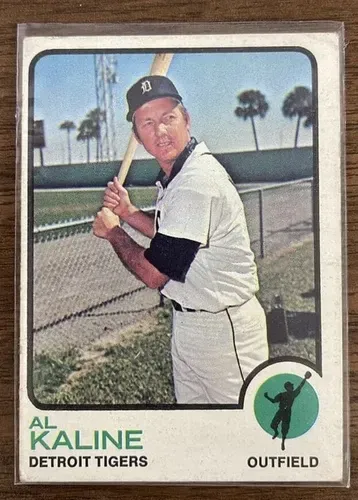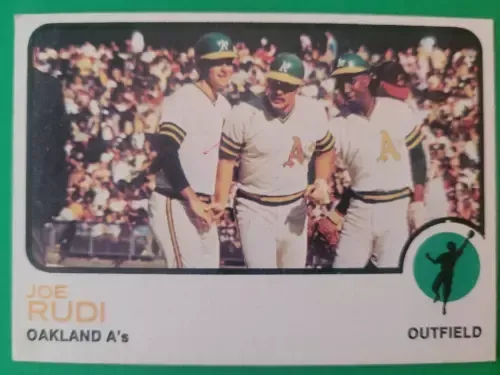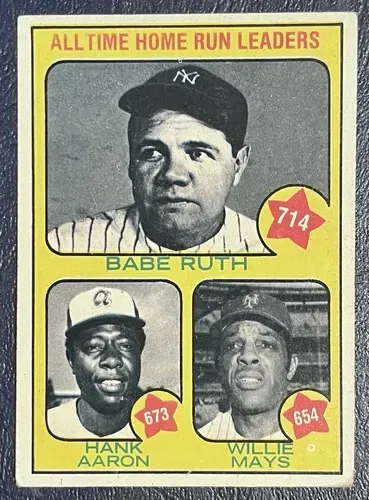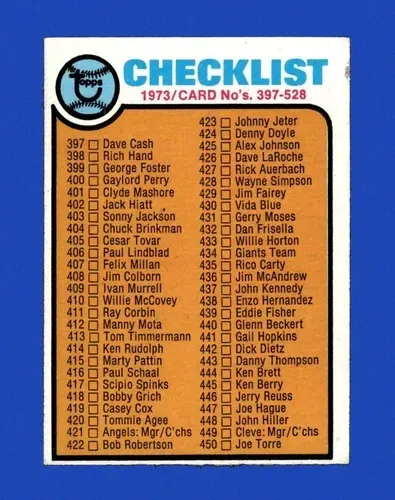An Analytical Review of the 1973 Topps Baseball Card Set: Production, Players, and Market Significance
Introduction
The 1973 Topps baseball card set occupies a unique and pivotal position in the history of the hobby. Released during a period of transition for both Major League Baseball and the Topps Chewing Gum Company, the set is notable not only for its player selection, including key rookie cards and the final issues for legendary figures, but also for its production characteristics and its status as the final Topps baseball set distributed in multiple series. This report provides an in-depth analysis of the 1973 Topps set, examining its structure, key cards, design elements, notable errors and variations, and its enduring significance for collectors.
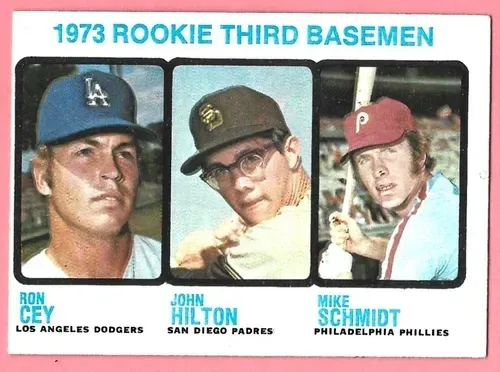
Set Fundamentals: The End of an Era in Distribution
The 1973 Topps baseball set comprises 660 standard-size cards, representing a significant reduction from the 787 cards issued in the 1972 set. This smaller set size, the most compact Topps baseball issue of the 1970s, resulted in fewer cards dedicated to lesser-known players and a reduction in the number of subsets compared to the previous year.
Critically, 1973 marked the final year Topps employed its long-standing practice of releasing baseball cards in multiple series throughout the season. The set was issued in five distinct series, each containing 132 cards. As was customary with multi-series releases, the final series, encompassing cards #529 through #660, was printed and distributed in smaller quantities. These "high numbers" are consequently scarcer and more challenging for collectors to acquire, particularly in high-grade condition. This scarcity directly influences the market value of cards within this range, most notably the Mike Schmidt rookie card (#615) and the final series checklist (#588). While the entire high-number series is less common, the term "short print" isn't typically applied to specific cards within the 1973 set in the same way it was used in earlier vintage issues; rather, the scarcity applies to the series as a whole.
The cessation of multi-series distribution after 1973 represented a fundamental shift in the baseball card landscape. For decades, collectors had engaged in the seasonal pursuit of later series cards, a defining characteristic of the vintage era. The move to single-series releases starting in 1974 standardized availability across the checklist from the beginning of the season, altering collecting habits and the nature of scarcity itself. The 1973 Topps set, therefore, stands as a significant historical marker, representing the conclusion of a defining production and distribution methodology and bridging the gap between distinct eras of baseball card collecting.
Key Rookie Cards: The Next Generation Takes the Field
The 1973 Topps set is anchored by the rookie cards of several future stars, most importantly two Hall of Famers.
- Mike Schmidt (#615): Widely considered the cornerstone card of the set, #615 features Schmidt alongside Ron Cey and John Hilton on a "Rookie Third Basemen" card. Its placement within the scarce high-number series significantly enhances its desirability and value. High-grade examples, particularly those graded PSA 8 or higher, command substantial prices in the market. It is worth noting that while Ron Cey appears on this card, his official Topps rookie card is found in the 1972 set.
- Goose Gossage (#174): The set's other key Hall of Fame rookie card features Gossage with Ron Diorio and Rich Hinton on a "Rookie Pitchers" card. Appearing in an earlier, more plentiful series, the Gossage rookie is more accessible than Schmidt's but remains a highly significant card. Gossage's induction into the Hall of Fame in 2008 further elevated interest in this card and the set as a whole.
Beyond the headline Hall of Famers, the set includes rookie cards for other notable players:
- Dwight Evans (#614): Sharing a "Rookie Outfielders" card with Al Bumbry and Charlie Spikes, this high-number card features the long-time Boston Red Sox star.
- Bob Boone (#613): Found on a high-number "Rookie Catchers" card with Bob Stinson and Earl Williams, this marks the debut of the durable catcher and future manager.
- Buddy Bell (#31): An early-series rookie card of the dependable third baseman and manager.
- Other rookies of note include Mac Scarce (#6), Steve Yeager (#59), Jim Willoughby (#79), Celerino Sanchez (#103), Lynn McGlothen (#114), Dave Goltz (#148), Ron Schueler (#169), Mike Caldwell (#182), Jorge Orta (#194), Ed Goodson (#197), Dave Hamilton (#214), and Tony Muser (#238).
The format of the "Rookie Stars" subset (#601-616) in 1973 deviated from some prior years. Instead of grouping rookies by team, Topps grouped them by position, placing three prospects on each card. This positional grouping means each rookie card technically belongs to three different team sets, a factor that can increase demand from team-specific collectors.
The strategic placement of the set's most valuable rookie card (Schmidt) and other significant debut cards (Evans, Boone) within the inherently scarcer high-number series (#529-660), combined with the three-player positional format, created a powerful confluence driving long-term value. While the multi-player format dilutes the focus on any single rookie, it simultaneously broadens the card's appeal to collectors of multiple teams. This increased demand, coupled with the restricted supply inherent in the high-number series, makes cards like #615 perpetually sought-after and challenging to acquire, especially in high-grade condition. This outcome, resulting from specific production choices regarding grouping and series placement, has cemented the status of these high-number rookie cards.
Table 1: Key 1973 Topps Rookie Cards
| Card # | Player(s) Featured | Position Group | Hall of Fame Status (Player) | Notes |
|---|---|---|---|---|
| 615 | Mike Schmidt / Ron Cey / John Hilton | Rookie Third Basemen | Mike Schmidt (Yes) | Key RC, High Number |
| 174 | Goose Gossage / Ron Diorio / Rich Hinton | Rookie Pitchers | Goose Gossage (Yes) | Key RC |
| 614 | Dwight Evans / Al Bumbry / Charlie Spikes | Rookie Outfielders | Dwight Evans (Borderline) | Notable RC, High Number |
| 613 | Bob Boone / Bob Stinson / Earl Williams | Rookie Catchers | Bob Boone (No) | Notable RC, High Number |
| 31 | Buddy Bell | Rookie Card | Buddy Bell (No) | Notable RC |
Established Stars and Hall of Fame Legacy
Beyond its significant rookie class, the 1973 Topps set boasts a remarkable concentration of established superstars and Hall of Famers, underpinning its broad collector appeal.
Two cards hold particular historical weight as the final regular Topps issues produced during the players' careers:
- Willie Mays (#305): Following his final season in 1973, this card marks the end of Mays' legendary playing career on cardboard. It is a highly sought-after card within the set.
- Roberto Clemente (#50): Issued posthumously following his tragic death in a plane crash on New Year's Eve 1972 while on a humanitarian mission, Clemente's final card carries unique poignancy and historical significance.
The checklist is further bolstered by numerous other icons of the era: Hank Aaron (#100), Nolan Ryan (#220), Pete Rose (#130), Johnny Bench (#380), Tom Seaver (#350), Reggie Jackson (#255), Carlton Fisk (#193), Brooks Robinson (#90), Harmon Killebrew (#170), Jim Palmer (#160), Bob Gibson (#190), Joe Morgan (#230), Ron Santo (#115), Don Sutton (#10), Luis Aparicio (#165), Bert Blyleven (#199), Al Kaline (#280), Thurman Munson (#142), Carl Yastrzemski (#245), and Rod Carew (#330) are just some of the prominent names included. The high number series also features Hall of Famers Jim Kaat (#530) and Orlando Cepeda (#545).
The 1973 Topps set serves as a tangible link between baseball generations. It simultaneously commemorates the conclusions of the careers of transcendent figures like Mays and Clemente while introducing the next wave of superstars like Schmidt and Gossage through their rookie cards. This unique convergence of farewells and introductions, occurring within the final Topps set distributed via the traditional series method, imbues the issue with a profound historical resonance and narrative depth, capturing a distinct moment of transition in baseball history.
Table 2: Notable Hall of Famers & Stars in 1973 Topps
| Card # | Player Name | Significance |
|---|---|---|
| 1 | Ruth/Aaron/Mays | All-Time HR Leaders (HOFers) |
| 10 | Don Sutton | HOF |
| 50 | Roberto Clemente | HOF, Final Card (Posthumous) |
| 61 | B. Williams/Carew | League Leaders (HOFers) |
| 62 | Bench/Allen | League Leaders (Bench HOF) |
| 63 | Bench/Allen | League Leaders (Bench HOF) |
| 65 | Carlton/Tiant | League Leaders (Carlton HOF) |
| 66 | Carlton/Perry/Wood | League Leaders (Carlton, Perry, Wood HOF) |
| 67 | Carlton/Ryan | League Leaders (Carlton, Ryan HOF) |
| 84 | Rollie Fingers | HOF |
| 90 | Brooks Robinson | HOF |
| 100 | Hank Aaron | HOF |
| 115 | Ron Santo | HOF |
| 130 | Pete Rose | All-Time Hit King |
| 142 | Thurman Munson | Star Catcher |
| 160 | Jim Palmer | HOF |
| 165 | Luis Aparicio | HOF |
| 170 | Harmon Killebrew | HOF |
| 190 | Bob Gibson | HOF |
| 193 | Carlton Fisk | HOF |
| 199 | Bert Blyleven | HOF |
| 220 | Nolan Ryan | HOF |
| 230 | Joe Morgan | HOF |
| 245 | Carl Yastrzemski | HOF |
| 255 | Reggie Jackson | HOF |
| 280 | Al Kaline | HOF (Band-Aid Variation exists) |
| 300 | Steve Carlton | HOF |
| 305 | Willie Mays | HOF, Final Card |
| 330 | Rod Carew | HOF |
Design Aesthetics: Simplicity Meets Action
The design of the 1973 Topps cards marked a departure from the bolder, more psychedelic aesthetic of the 1972 set, opting for a cleaner, simpler presentation.
- Card Front: The front is dominated by a large player photograph, surrounded by clean white borders. A key feature is the increased use of action photography, with many dynamic shots included alongside traditional posed portraits. Notably, several action shots utilize a horizontal ("landscaped") orientation, requiring the card to be turned sideways. In the lower portion of the card (typically the right corner, but sometimes left), a small, solid-color silhouette of a player representing the athlete's primary position is placed within a contrasting colored circle. The player's name, team affiliation, and position are usually printed below the photograph.
- Card Back: The card backs feature a vertical layout, the first time Topps utilized this orientation for a regular-issue baseball set since 1968. Information presented includes biographical data, comprehensive year-by-year and career statistics, and a small cartoon panel illustrating a fact or highlight about the player. The card number is clearly displayed within a baseball graphic. Card backs were printed primarily in black ink, often with a secondary highlight color (like red or green). The black ink used for the text and borders, combined with the relatively light card stock, makes the backs susceptible to chipping and edge wear, particularly noticeable on high-grade examples.
- Photography and Production: The set is recognized for its significant number of action photos. Topps continued the practice of airbrushing uniforms to reflect off-season trades when current photos were unavailable. Examples include Tommie Agee (#420), whose Mets uniform details were airbrushed to Astros colors, and Dave Johnson (#550), whose Orioles uniform was altered to Braves colors. The overall design has received mixed reactions from collectors over the years; some appreciate its straightforward simplicity, while others find it somewhat uninspired compared to other 1970s designs.
Interestingly, the 1973 Topps set presents a paradox: its front design aimed for relative simplicity and clarity, especially compared to its flamboyant predecessor, yet the set's production was fraught with complexities and inconsistencies. Numerous documented errors, significant variations (particularly among the manager cards), widespread centering and cutting problems, and photo mistakes plagued the set. This suggests a possible disconnect between the intended design and the realities of manufacturing execution. Topps was concurrently producing multiple sports card sets (football, hockey, basketball) as well as popular non-sport lines like Wacky Packages in 1973. These extensive demands on what was reportedly a lean staff may have stretched resources thin, leading to quality control challenges that manifested despite the visually simpler card design.
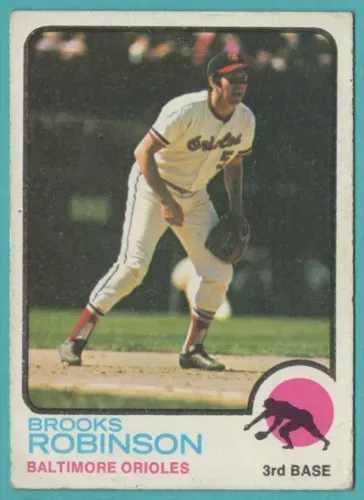
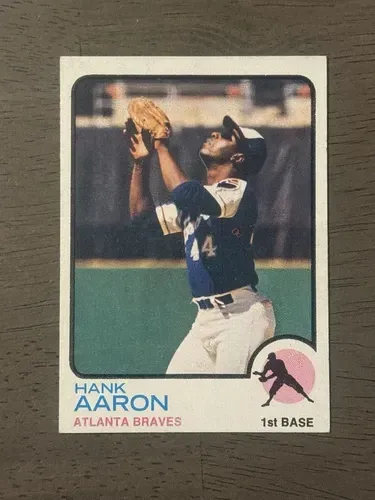
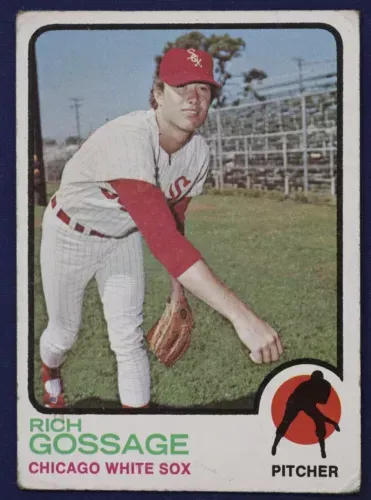
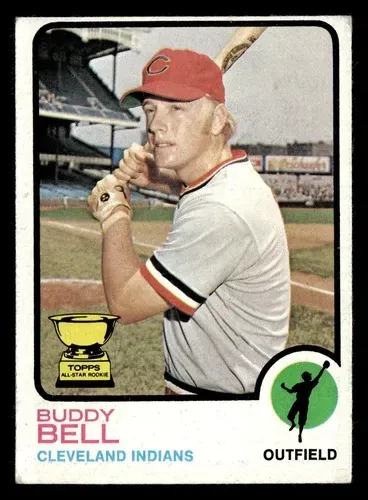

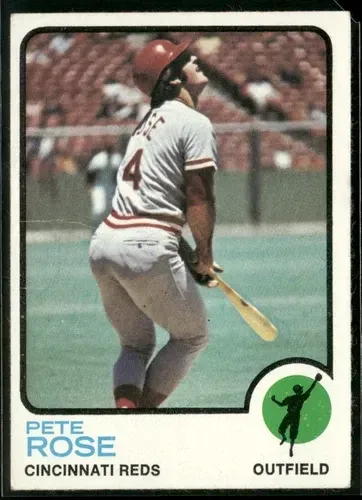
Errors, Variations, and Printing Quirks: A Collector's Chase
The 1973 Topps set is renowned among collectors for its abundance of errors, variations, and printing anomalies, adding layers of complexity and intrigue to set building.
- Uncorrected Errors (UERs): These are mistakes that persisted throughout the print run without correction.
- #80 Tony Oliva: The front of the card famously misspells the Minnesota Twins team name as "MINNSEOTA".
- #11 Chris Chambliss: The back of the card contains a misspelling of his listed hometown ("Hacienda Hts.").
- Accepted Variations: These are distinct differences acknowledged by the collecting community, often carrying premium values.
- Manager/Coach Cards: This subset is the most fertile ground for variations. Documented differences include variations in the background of the inset coach photos (solid color fill vs. a natural, photographic background) on cards like #49 Twins, #81 Cubs, and #116 Yankees. Background color shifts (e.g., orange vs. brown) appear on cards such as #136 Orioles, #252 Giants, and #257 Mets. Cropping differences in the coach photos leading to parts of an ear being visible or obscured ("Ear Variations") are noted on #12 Padres (Johnny Podres' right ear), #131 Red Sox, #179 A's, #237 Braves, #449 Indians, and #517 Pirates. The Podres ear variation is recognized by major grading services.
- #280 Al Kaline "Band-Aid": A scarce and sought-after variation shows what appears to be a bandage on Kaline's arm or hand in the photograph. This is considered a true variation by many collectors. It is exceptionally rare, particularly in high grades; PSA population reports have indicated zero examples graded PSA 8.
- Blue Team Checklists: These unnumbered inserts have confirmed variations featuring either one asterisk (*) or two asterisks (**) printed on the back, generally accepted as true variations.
- Photo Errors/Swaps:#360 Joe Rudi: The card incorrectly pictures teammate Gene Tenace.
- #45 Ellie Rodriguez: Some resources suggest the photo may actually be of John Felske or Paul Ratliff.
- Printing Quality Issues (Miscuts/Centering): Perhaps the most pervasive issue across the entire set is poor centering and rough cuts. Cards are frequently found significantly off-center horizontally, vertically, or both. This makes well-centered examples, especially in Near Mint or better condition, considerably harder to find and more valuable than their off-center counterparts.
The distinction between a "true variation" and a mere "print defect" often sparks debate within the hobby. Generally, consistent, identifiable differences appearing across numerous examples (like the manager card background types or the Kaline band-aid) gain acceptance as variations. Random, inconsistent flaws like ink spots or minor color fluctuations are typically dismissed as printing defects. Ultimately, recognition by major grading services, inclusion in standard price guides, and collector consensus play significant roles in determining whether an anomaly is treated as a collectible variation. This process highlights how collector perception and market forces actively shape the definition of collectibility, elevating certain production flaws to sought-after status while others remain simple imperfections. The journey from print flaw to recognized variation underscores the dynamic interplay between manufacturer output and hobby culture.
Table 3: Summary of Key 1973 Topps Errors and Variations
| Card # | Player/Subject | Type | Description | Notes |
|---|---|---|---|---|
| 11 | Chris Chambliss | UER | Hometown misspelled on back | Uncorrected Error |
| 12 | Padres Mgr./Coaches | Variation | Podres photo: Right ear missing vs. Right ear visible | Accepted Variation |
| 45 | Ellie Rodriguez | Photo Error? | Photo might be John Felske or Paul Ratliff | Speculative |
| 49 | Twins Mgr./Coaches | Variation | Coach photo background: Solid vs. Natural | Accepted Variation |
| 80 | Tony Oliva | UER | Team name "MINNSEOTA" on front | Accepted UER |
| 81 | Cubs Mgr./Coaches | Variation | Coach photo background: Solid vs. Natural | Accepted Variation |
| 116 | Yankees Mgr./Coaches | Variation | Coach photo background: Solid vs. Natural | Accepted Variation |
| 131 | Red Sox Mgr./Coaches | Variation | Ear visible/missing in coach photo | Variation noted |
| 136 | Orioles Mgr./Coaches | Variation | Coach photo background: Orange vs. Brown | Accepted Variation |
| 179 | A's Mgr./Coaches | Variation | Ear visible/missing in coach photo | Variation noted |
| 237 | Braves Mgr./Coaches | Variation | Ear visible/missing in coach photo | Variation noted |
| 252 | Giants Mgr./Coaches | Variation | Coach photo background: Orange vs. Brown | Accepted Variation |
| 257 | Mets Mgr./Coaches | Variation | Coach photo background: Orange vs. Brown | Accepted Variation |
| 280 | Al Kaline | Variation | "Band-Aid" visible on arm/hand | Accepted Variation, Very Rare High Grade |
| 360 | Joe Rudi | Photo Swap | Photo is of Gene Tenace | Accepted Photo Error |
| 421 | Angels Mgr./Coaches | Variation | Coach photo background: Orange vs. Brown | Accepted Variation |
| 449 | Indians Mgr./Coaches | Variation | Ear shape difference in coach photo | Variation noted |
| 486 | Phillies Mgr./Coaches | Variation | Coach photo background: Orange vs. Brown | Accepted Variation |
| 497 | Cardinals Mgr./Coaches | Variation | Coach photo background: Orange vs. Brown | Accepted Variation |
| 517 | Pirates Mgr./Coaches | Variation | Ear visible/missing in coach photo | Variation noted |
| NNO | Blue Team Checklists | Variation | Asterisk (*) or Double Asterisk (**) on back | Accepted Variation |
| Various | All Cards | Print Defect | Poor Centering / Miscuts | Extremely Common Issue |
Subsets and Special Inserts
The 1973 Topps set integrated several themed subsets directly into the main 660-card numbering sequence, along with other standard card types and a notable unnumbered insert.
- Numbered Subsets:All-Time Leaders: Card #1 kicks off the set featuring the All-Time Home Run Leaders (Babe Ruth, Hank Aaron, Willie Mays). A dedicated subset follows later with cards #471-478, highlighting career leaders in various statistical categories, including legends like Ty Cobb and Lou Gehrig.
- League Leaders: Cards #61-68 showcase the statistical leaders from both the American and National Leagues on combined cards for categories like Batting Average, Home Runs, RBIs, Stolen Bases, ERA, Wins, and Strikeouts.
- Playoff Highlights: Cards #201 (ALCS) and #202 (NLCS) summarize the previous season's League Championship Series.
- World Series Highlights: Cards #203-210 depict key moments and players from the 1972 World Series between the Oakland Athletics and Cincinnati Reds.
- Boyhood Photos of the Stars: A small subset (#341-346) featuring childhood pictures of prominent players.
- Rookie Stars: Cards #601-616, located in the high-number series, feature trios of promising prospects grouped by position.
- Other Included Card Types:Team Cards: Standard team photo cards are scattered throughout the set (e.g., #7 Texas Rangers, #26 Pittsburgh Pirates).
- Manager & Coach Cards: These multi-player cards feature the team's manager alongside smaller photos of the coaching staff. They are distributed throughout the set and are the source of numerous variations.
- Checklists: Numbered checklists for different series appear within the set (e.g., #54 covers cards 1-132). The high-number checklist, #588 (covering #529-660), is particularly noteworthy due to its placement in the scarcer final series and is considered a tougher card to acquire.
- Unnumbered Inserts:Blue Team Checklists: Randomly inserted into packs containing high-number series cards, these unnumbered checklists feature a blue border and were produced for each of the 24 MLB teams. They are considered scarce and are particularly difficult to find in high-grade condition due to poor centering and the tendency for collectors to mark them. Variations with one or two asterisks on the back exist and are considered true variations. O-Pee-Chee, Topps' Canadian counterpart, also issued these checklists, distinguishable by their bilingual backs.
